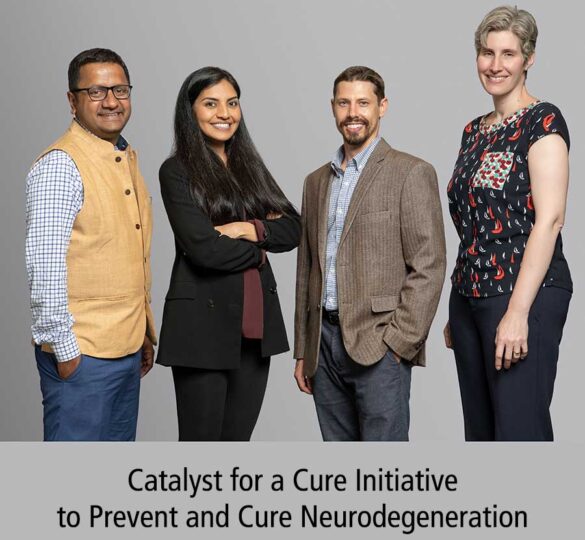Fourth Catalyst for a Cure Tackles Neurodegeneration

Made possible by visionary donors, Glaucoma Research Foundation’s latest research initiative targets the shared roots of conditions that occur when neurons deteriorate and die.
In July 2022, a new team of brilliant investigators met for the first time to kick off the Melza M. and Frank Theodore Barr Catalyst for a Cure Initiative to Prevent and Cure Neurodegeneration.
This bold research endeavor — the latest in the Foundation’s flagship research program — advances the quest for a future free from glaucoma by investigating what glaucoma has in common with Alzheimer’s disease, Parkinson’s disease, and amyotrophic lateral sclerosis (ALS).
These and other complex conditions occur when nerve cells in the central nervous system — eye, brain, spinal cord — deteriorate and die, a process called neurodegeneration.
“Neurodegeneration represents a promising but perplexing frontier in human health,” says Tom Brunner, President and CEO for Glaucoma Research Foundation. “Currently no therapies exist that can prevent or halt neurodegeneration or regrow healthy neurons and restore vision, memory, or other losses of function. We hope to contribute new insights that could lead to innovative treatments and cures for glaucoma as well as other neurodegenerative conditions.”
The Neurodegeneration Initiative was launched through a transformative $2.4 million gift to GRF from the Melza M. and Frank Theodore Barr Foundation. Philanthropist and former GRF board member Frank Theodore (Ted) Barr and his wife Melza have supported the Foundation for 40 years and were significant investors in the inaugural Catalyst for a Cure consortium.
Possibly the first biomedical research endeavor of its kind, the Neurodegeneration Initiative challenges conventional wisdom by applying the groundbreaking Catalyst for a Cure model of interdisciplinary teamwork across an entire family of diseases.
By bringing together innovative investigators whose paths would not otherwise cross, the Catalyst model provides unique potential for outside-the-box scientific creativity — the kind of high-risk/high-reward research that rarely wins support from traditional funders.
With the Neurodegeneration Initiative under way, GRF is now funding two simultaneous Catalyst for a Cure consortia, each with the potential to change the lives of people with glaucoma. Ongoing since 2019, the Catalyst for a Cure Vision Restoration Initiative has made enormous strides that could soon result in the ability to protect, and even regenerate retinal ganglion cells — elements of the optic nerve that degenerate and die over time with glaucoma, causing blindness.
Photo by Jay Watson. Posted August 24, 2022